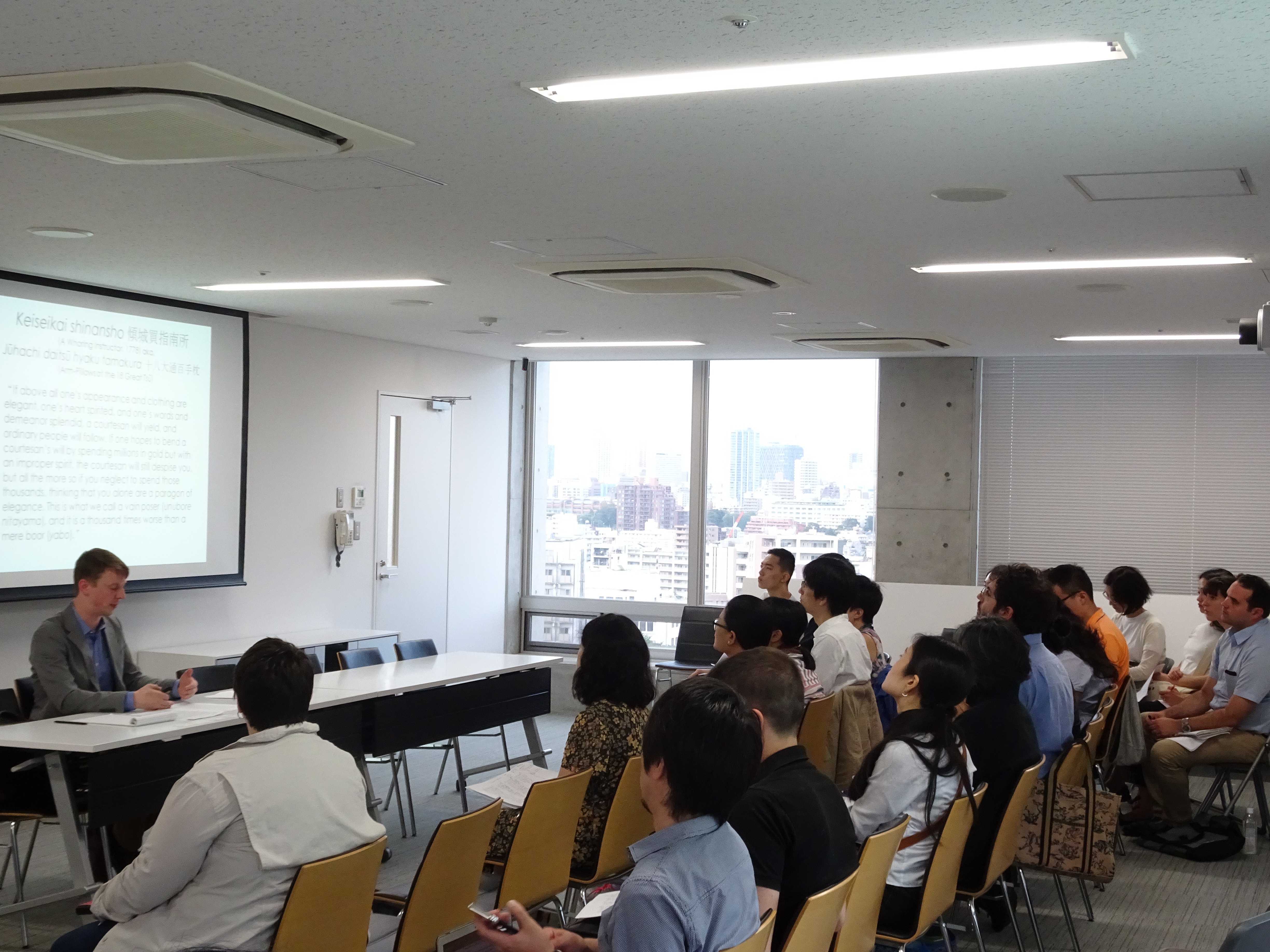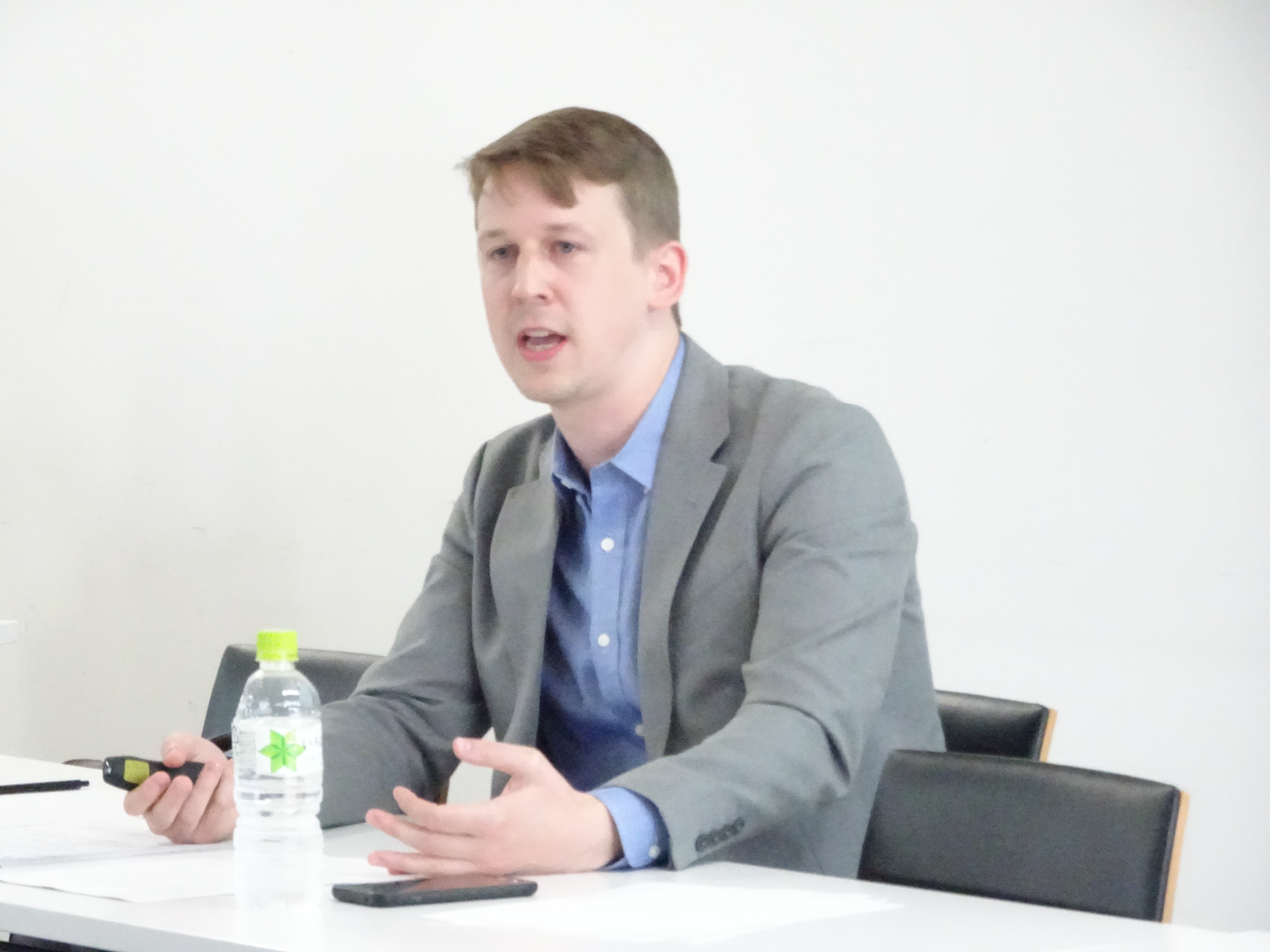Lecture by Assistant Professor Thomas Gaubatz
The Phantasmal Sophisticate: Mediation and Distinction in 18th-Century Edo
This lecture was sponsored by Waseda University’s Global Japanese Studies Model Unit of the Top Global University Project and co-sponsored by the Waseda University Research Institute for Letters, Arts and Sciences and the Ryusaku Tsunoda Center of Japanese Culture. Despite taking place during the university’s summer break, the lecture drew numerous attendees, including an international group of researchers from Waseda University and other institutions, as well as other faculty members and students.

For this lecture event, titled “The Phantasmal Sophisticate: Mediation and Distinction in 18th-Century Edo,” Thomas Gaubatz, an assistant professor at Northwestern University’s Department of Asian Languages and Cultures, was invited to speak.
The event started with opening remarks by Waseda University Professor Hirokazu Toeda. Professor Toeda explained the objective of the lecture and introduced the audience to the lecturer, Thomas Gaubatz, as well as Waseda University’s Professor Takashi Nakajima, who took on the role of commentator. Gaubatz specializes in early modern Japanese literature and media and has focused his research on the depiction of characters through urban spaces and identities portrayed in literature.
Gaubatz’s lecture reconsidered the meaning and evolution of the character archetype known as the tsū or tsūjin in the gesaku (a category of humorous written works for a mass readership) in Edo (modern-day Tokyo) during the Anei and Tenmei periods (1772–1789). The lecture focused on the genre of gesaku called sharebon, which so often depicted tsūjin and the conditions that purportedly made a character belong to this archetype to the extent that they were also known as “tsū books.” By viewing sharebon as a distinct medium, Gaubatz provided a new understanding of the tsū, who has heretofore been discussed in terms of the particular aesthetic notions or of ideals concerning lifestyles that existed during the era. Thus, Gaubatz explained, the lack of agreement as to what attributes made a character a tsū/tsūjin produced, precisely because of the vagueness of the meaning of those terms, a discourse space in which authors of different social status disputed their cultural authority with one another. In conclusion, Gaubatz argued that sharebon was a medium that made possible the phantasmal character of the tsū.

After the lecture proper, the commentator, Professor Takashi Nakajima, began by summarizing the significance of Gaubatz’s argument, which criticized the existing conceptualization of sharebon as attempts to convey the aesthetic notion of the tsū to readers. Professor Nakajima then posed two questions: How was the figure of the tsū involved in influencing the Kansei Reforms, and what was sought by the mass readership of sharebon?
After the discussion between the designated commentator and Gaubatz, the floor was opened to questions and answers involving the audience. There was a lively discussion, with a variety of questions and comments. One attendee responded to Gaubatz’s assertion that authors of different social status used sharebon to present readers with cultural information, eventually creating a “venue to dispute cultural authority”: Perhaps we should draw our attention to the language used in those disputes, as well as to the fashion styles, other markers of social status, and the cultures that followed from those statuses, as cyphers for understanding such differences.
At the end of the event, Professor Kimiko Kono of Waseda University used her closing remarks to touch upon how Gaubatz’s argument might be applied to transcend eras and areas of specialization, affirming the significance of providing, through “international Japanese studies,” a new perspective on Japanese studies as it currently exists. The lecture event then concluded as a rousing success.
<Event Contents>
Lecture title: The Phantasmal Sophisticate: Mediation and Distinction in 18th-Century Edo
Date and time: Friday, September 14, 2018 (Fri.) 4:30 pm to 6:00 pm
Venue: Meeting Room 10, 16th floor of Building 33, Toyama Campus, Waseda University
Sponsored by: Waseda University’s Global Japanese Studies Model Unit, Top Global University Project
Co-sponsored by: Waseda University Research Institute for Letters, Arts and Sciences and the Ryusaku Tsunoda Center of Japanese Culture
Opening remarks: Hirokazu Toeda (Professor, Waseda University)
Lecture: Thomas Gaubatz (Assistant Professor, Northwestern University)
Commentator: Takashi Nakajima (Professor, Waseda University)
Closing remarks: Kimiko Kono (Professor, Waseda University)
Moderators: Pau Pitarch-Fernandez (Associate Professor, Waseda University)
Kim Young-Long (Guest Lecturer, Waseda University Research Council)
Coordinator: Hiroki Matsumoto (Guest Associate Professor, Waseda University Research Council)


